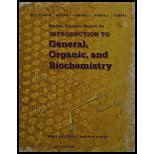
Concept explainers
3-29 Answer true or false.
(a) According to the Lewis model of bonding, atoms bond together in such a way that each atom participating in the bond acquires an outer-shell electron configuration matching that of the noble gas nearest to it in
(b) Atoms that lose electrons to achieve a filled valence shell become cations and form ionic bonds with anions.
(c) Atoms that gain electrons to achieve filled valence shells become anions and form ionic bonds with cations.
(d) Atoms that share electrons to achieve filled valence shells form covalent bonds.
(e) Ionic bonds tend to form between elements on the left side of the Periodic Table, and covalent bonds tend to form between elements on the right side of the Periodic Table.
(f) Ionic bonds tend to form between a metal and a nonmetal.
(g) When two nonmetals combine, the bond between them is usually covalent.
(h) Electronegativity is a measure of an atom’s at traction for the electrons it shares in a
(j) Electronegativity generally increases with atomic number.
(j) Electronegativity generally increases with atomic weight.
(k) Electronegativity is a periodic property.
(l) Fluorine, in the upper-right corner of the Periodic Table, is the most electronegative element; hydrogen, in the upper-left corner, is the least electronegative element.
(m)Electronegativity depends on both the nuclear charge and the distance of the valence electrons from the nucleus.
(n) Electronegativity generally increases from left to right across a period of the Periodic Table.
(o) Electronegativity generally increases from top to bottom in a column of the Periodic Table.
Trending nowThis is a popular solution!

Chapter 3 Solutions
Student Solutions Manual for Bettelheim/Brown/Campbell/Farrell/Torres' Introduction to General, Organic and Biochemistry, 11th
- Draw the mechanism for the following reaction: CH3 CH3 Et-OH Et Edit the reaction by drawing all steps in the appropriate boxes and connecting them with reaction arrows. Add charges where needed. Electron-flow arrows should start on the electron(s) of an atom or a bond and should end on an atom, bond, or location where a new bond should be created. H± EXP. L CONT. י Α [1] осн CH3 а CH3 :Ö Et H 0 N о S 0 Br Et-ÖH | P LL Farrow_forward20.00 mL of 0.150 M NaOH is titrated with 37.75 mL of HCl. What is the molarity of the HCl?arrow_forward20.00 mL of 0.025 M HCl is titrated with 0.035 M KOH. What volume of KOH is needed?arrow_forward
- 20.00 mL of 0.150 M NaOH is titrated with 37.75 mL of HCl. What is the molarity of the HCl?arrow_forward20.00 mL of 0.025 M HCl is titrated with 0.035 M KOH. What volume of KOH is needed?arrow_forward20.00 mL of 0.150 M HCl is titrated with 37.75 mL of NaOH. What is the molarity of the NaOH?arrow_forward
- Calculate the pH of 0.450 M KOH.arrow_forwardWhich does NOT describe a mole? A. a unit used to count particles directly, B. Avogadro’s number of molecules of a compound, C. the number of atoms in exactly 12 g of pure C-12, D. the SI unit for the amount of a substancearrow_forward5 What would the complete ionic reaction be if aqueous solutions of potassium sulfate and barium acetate were mixed? ed of Select one: O a 2 K SO4 + Ba2 +2 C₂H3O21 K+SO4 + Ba2+ + 2 C2H3O21 K+SO42 + Ba2 +2 C2H3O2 BaSO4 +2 K+ + 2 C2H3O estion Ob. O c. Od. 2 K SO4 +Ba2 +2 C₂H₂O₂ BaSO4 + K+ + 2 C2H3O BaSO4 + K + 2 C2H301 →Ba² +SO42 +2 KC2H3O s pagearrow_forward
 Introduction to General, Organic and BiochemistryChemistryISBN:9781285869759Author:Frederick A. Bettelheim, William H. Brown, Mary K. Campbell, Shawn O. Farrell, Omar TorresPublisher:Cengage Learning
Introduction to General, Organic and BiochemistryChemistryISBN:9781285869759Author:Frederick A. Bettelheim, William H. Brown, Mary K. Campbell, Shawn O. Farrell, Omar TorresPublisher:Cengage Learning Chemistry: The Molecular ScienceChemistryISBN:9781285199047Author:John W. Moore, Conrad L. StanitskiPublisher:Cengage Learning
Chemistry: The Molecular ScienceChemistryISBN:9781285199047Author:John W. Moore, Conrad L. StanitskiPublisher:Cengage Learning Living By Chemistry: First Edition TextbookChemistryISBN:9781559539418Author:Angelica StacyPublisher:MAC HIGHER
Living By Chemistry: First Edition TextbookChemistryISBN:9781559539418Author:Angelica StacyPublisher:MAC HIGHER Introductory Chemistry: A FoundationChemistryISBN:9781337399425Author:Steven S. Zumdahl, Donald J. DeCostePublisher:Cengage Learning
Introductory Chemistry: A FoundationChemistryISBN:9781337399425Author:Steven S. Zumdahl, Donald J. DeCostePublisher:Cengage Learning



